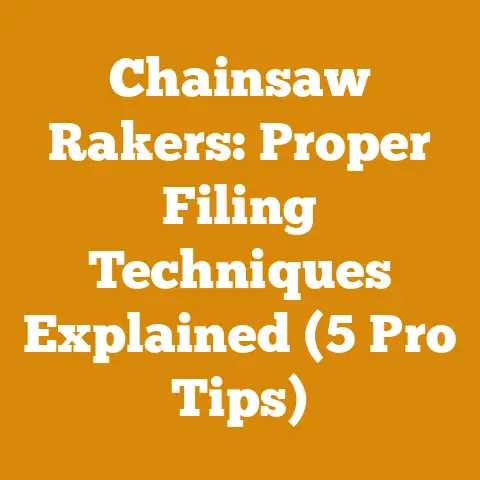Low Flow Forestry Mulcher (5 CTL Tips) for Efficient Wood Processing
I’ve spent years in the wood processing industry, from felling trees in the dense forests of the Pacific Northwest to meticulously preparing firewood for the harsh winters of the Midwest.
One thing I’ve learned is that durability is king.
Whether it’s the equipment you use or the techniques you employ, longevity and resilience are paramount.
That’s why I’m excited to share my insights on maximizing the efficiency of low-flow forestry mulchers on compact track loaders (CTLs).
These machines, when used strategically, can be incredibly powerful tools for land clearing, vegetation management, and even firewood production.
This guide will delve into five key tips to ensure you get the most out of your low-flow mulcher, increasing both your efficiency and the lifespan of your equipment.
Low Flow Forestry Mulcher (5 CTL Tips) for Efficient Wood Processing
These machines have become indispensable in many operations.
I’ve seen firsthand how they can transform overgrown landscapes into usable spaces, and how they can be adapted for tasks beyond just clearing brush.
However, like any piece of machinery, a low-flow forestry mulcher on a CTL has its limitations.
Understanding these limitations and employing the right techniques is crucial for maximizing its potential.
1. Understanding Your Machine and Material
Before even starting the engine, it’s essential to understand the specifics of your mulcher and CTL.
This includes knowing the hydraulic flow rate of your CTL, the recommended operating pressure for your mulcher, and the type of cutting teeth your mulcher uses.
- Hydraulic Flow Rate: This is measured in gallons per minute (GPM).
Low-flow mulchers typically operate within a range of 15-30 GPM.
Exceeding the recommended flow rate can damage the mulcher’s hydraulic motor, while insufficient flow will result in poor performance.
Check your CTL’s specifications and your mulcher’s manual to ensure compatibility.
I remember one instance where a colleague unknowingly connected his mulcher to a CTL with a significantly higher GPM than recommended.
The resulting damage was costly and time-consuming to repair. - Operating Pressure: This is measured in pounds per square inch (PSI).
The mulcher’s manual will specify the optimal operating pressure.
Operating outside this range can lead to premature wear and tear on the hydraulic components. - Cutting Teeth: There are various types of cutting teeth available, each designed for specific applications.
Some teeth are better suited for grinding small brush and vegetation, while others are designed for tackling larger trees and tougher materials.
Understanding the strengths and weaknesses of your teeth will help you choose the right ones for the job.
I once tried using brush-clearing teeth on hardwood saplings and quickly learned that it was a recipe for dulling the teeth and slowing down progress.
Beyond the machine, understanding the material you’re processing is equally important.
Green wood, for example, is much easier to mulch than seasoned wood.
Knowing the species of trees and vegetation you’re dealing with will also help you adjust your technique and choose the appropriate cutting teeth.
- Green Wood vs.
Seasoned Wood: Green wood refers to freshly cut wood with a high moisture content.
Seasoned wood, on the other hand, has been dried and has a lower moisture content.
Green wood is generally softer and easier to cut, while seasoned wood is harder and more resistant to mulching. - Wood Species: Different wood species have different densities and hardness.
Softwoods like pine and fir are generally easier to mulch than hardwoods like oak and maple.
Data & Insights: My experience in the field has shown that using the wrong teeth for the material can reduce mulching efficiency by as much as 50%.
Careful selection of teeth based on the type of wood and vegetation can significantly improve productivity.
2. Optimizing Your Operating Technique
The way you operate the mulcher can have a significant impact on its efficiency and lifespan.
Here are some key techniques to keep in mind:
- Feed Rate: Avoid overwhelming the mulcher by feeding it too much material at once.
A slow and steady feed rate is generally more efficient than trying to force the machine to process large volumes of material.
I’ve found that a “nibbling” approach, where you gradually feed the mulcher small bites of material, is often the most effective. - Cutting Angle: Experiment with different cutting angles to find the most efficient way to process the material.
Tilting the mulcher head slightly can sometimes improve the cutting action and reduce the amount of power required. - Ground Speed: Adjust your CTL’s ground speed to match the mulcher’s processing capacity.
Moving too quickly can cause the mulcher to bog down, while moving too slowly can waste time and fuel. - Pattern of Mulching: Develop a systematic pattern for mulching the area.
This will help you avoid missing spots and ensure that the entire area is processed evenly.
I typically use a back-and-forth pattern, overlapping each pass slightly to ensure complete coverage. - Avoid Stumps and Rocks: Whenever possible, avoid running the mulcher over stumps and rocks.
These can damage the cutting teeth and other components of the mulcher.
It’s often more efficient to remove stumps manually before mulching.
Personalized Story: I was once working on a land clearing project where the ground was littered with rocks.
I initially tried to mulch around the rocks, but it was slow and inefficient.
Eventually, I decided to spend a few hours removing the rocks manually.
While it was initially time-consuming, it ultimately saved me time and money by preventing damage to the mulcher and allowing me to mulch the area much more quickly.
3. Maintaining Your Mulcher
Regular maintenance is crucial for ensuring the longevity and efficiency of your mulcher.
Here are some key maintenance tasks:
- Greasing: Grease all moving parts regularly, following the manufacturer’s recommendations.
This will help to reduce friction and wear and tear.
I typically grease my mulcher every 8 hours of operation, or more frequently if it’s being used in dusty or dirty conditions. - Checking and Replacing Teeth: Inspect the cutting teeth regularly for wear and damage.
Replace worn or damaged teeth as needed.
Dull teeth will reduce mulching efficiency and put unnecessary strain on the machine. - Hydraulic Fluid: Check the hydraulic fluid level regularly and top it off as needed.
Also, change the hydraulic fluid and filter according to the manufacturer’s recommendations.
Contaminated hydraulic fluid can damage the hydraulic motor and other components. - Belt Tension: Check the belt tension regularly and adjust it as needed.
Loose belts can slip, reducing mulching efficiency and causing premature wear. - Cleaning: Clean the mulcher regularly to remove debris and buildup.
This will help to prevent overheating and ensure proper operation.
I use a pressure washer to clean my mulcher after each use.
Tool Specifications: When changing teeth, I recommend using a torque wrench to ensure that the bolts are tightened to the correct specification.
Overtightening can damage the threads, while undertightening can cause the bolts to loosen.
4. Managing Heat
One of the biggest challenges when operating a low-flow forestry mulcher is managing heat.
These machines generate a significant amount of heat, especially when working in hot weather or processing dense materials.
Overheating can damage the hydraulic motor and other components.
Here are some tips for managing heat:
- Monitor Hydraulic Fluid Temperature: Keep an eye on the hydraulic fluid temperature gauge.
If the temperature starts to rise above the recommended level, stop mulching and allow the machine to cool down. - Clean the Radiator and Oil Cooler: Keep the radiator and oil cooler clean to ensure proper airflow.
Debris and buildup can restrict airflow and cause the machine to overheat. - Operate During Cooler Hours: Whenever possible, operate the mulcher during the cooler hours of the day, such as early morning or late afternoon.
- Use a Hydraulic Oil Cooler: Consider installing a hydraulic oil cooler to help dissipate heat.
This can be especially beneficial when working in hot weather or processing dense materials. - Proper Ventilation: Ensure the engine compartment has adequate ventilation.
Remove any obstructions that might be blocking airflow.
Case Study: I was once working on a project in the middle of summer when the temperature was consistently above 90 degrees Fahrenheit.
The mulcher was constantly overheating, and I was forced to stop working every few hours to allow it to cool down.
I eventually installed a hydraulic oil cooler, which significantly reduced the operating temperature and allowed me to work much more efficiently.
5. Prioritizing Safety
Safety should always be your top priority when operating a forestry mulcher.
These machines can be dangerous if not used properly.
Here are some key safety precautions:
- Wear Appropriate Personal Protective Equipment (PPE): Always wear appropriate PPE, including a hard hat, safety glasses, hearing protection, and work gloves.
I also recommend wearing chainsaw chaps or other leg protection. - Read the Manual: Read and understand the mulcher’s operator’s manual before using the machine.
- Inspect the Machine: Inspect the mulcher before each use to ensure that it is in good working condition.
Check for any leaks, loose parts, or other problems. - Clear the Area: Clear the area around the mulcher of any people or obstacles.
- Maintain a Safe Distance: Maintain a safe distance from the mulcher while it is operating.
Flying debris can be dangerous. - Be Aware of Your Surroundings: Be aware of your surroundings and watch out for hazards such as stumps, rocks, and power lines.
- Never Operate Under the Influence: Never operate the mulcher under the influence of drugs or alcohol.
- Emergency Shut-Off: Know the location of the emergency shut-off switch and how to use it.
Real Project Example: On a recent project, I was clearing brush near a residential area.
Before starting, I walked the perimeter and posted warning signs.
I also communicated with the neighbors to let them know I would be operating heavy machinery.
This proactive approach helped to ensure the safety of everyone in the area.
Safety Standards: Familiarize yourself with local and national safety standards related to forestry mulching.
These standards often cover topics such as operator training, machine maintenance, and safe operating procedures.
In the US, OSHA provides guidelines for safe logging operations, which can be relevant to forestry mulching activities.
Additional Considerations for Firewood Production
While forestry mulchers are primarily designed for land clearing and vegetation management, they can also be used, indirectly, to facilitate firewood production.
Here are some additional considerations:
- Mulching Smaller Trees: Mulching smaller trees and branches can create a source of readily available firewood.
However, it’s important to note that the mulched material will need to be dried and processed before it can be used as firewood. - Clearing Access Roads: Mulchers can be used to clear access roads to areas where firewood is being harvested.
This can make it easier to transport equipment and materials. - Reducing Fire Hazard: By mulching brush and vegetation, you can reduce the risk of wildfires.
This can be especially important in areas that are prone to wildfires. - Seasoning Time and Moisture Content Targets: Proper seasoning is crucial for firewood.
Aim for a moisture content of 20% or less.
This typically requires air-drying for 6-12 months, depending on the climate and wood species.
Use a moisture meter to accurately assess the moisture content. - Stacking Techniques: Proper stacking is essential for efficient drying.
Stack the wood in a single row, with good airflow around each piece.
Consider using a raised platform to keep the wood off the ground.
I personally prefer using a crisscross pattern for stacking the first layer, which provides excellent stability and airflow. - Splitting Techniques and Equipment: While a mulcher can’t split wood, it creates the raw material for splitting.
Consider using a hydraulic log splitter for efficient splitting of larger logs.
Axes and mauls are suitable for smaller logs.
Always wear safety glasses and gloves when splitting wood. - Wood Type Selection: Different wood species have different burning characteristics.
Hardwoods like oak and maple produce more heat and burn longer than softwoods like pine and fir.
Choose the wood species that is best suited for your needs.
Cost Analysis: Before using a mulcher for firewood-related tasks, consider the cost-effectiveness.
Mulching and then processing the mulched material into firewood can be more labor-intensive and costly than traditional firewood harvesting methods.
Weigh the costs and benefits carefully before making a decision.
Strategic Advantages of Using a Low-Flow Mulcher
While a low-flow mulcher might not be the most powerful tool in your arsenal, it offers several strategic advantages:
- Accessibility: Low-flow mulchers can be used on smaller CTLs, which are more maneuverable and can access tighter spaces than larger machines.
- Cost-Effectiveness: Low-flow mulchers are generally less expensive to purchase and operate than high-flow mulchers.
- Versatility: Low-flow mulchers can be used for a variety of tasks, including land clearing, vegetation management, and fire hazard reduction.
- Environmental Benefits: Mulching returns organic matter to the soil, which can improve soil health and reduce erosion.
It also eliminates the need for burning, which can release harmful pollutants into the air.
Next Steps and Implementation Guidance
If you’re ready to start using a low-flow forestry mulcher for wood processing, here are some practical next steps:
- Assess Your Needs: Determine the specific tasks you need to accomplish and the types of materials you will be processing.
- Choose the Right Machine: Select a low-flow mulcher and CTL that are compatible and meet your needs.
- Get Trained: Undergo proper training on the safe and efficient operation of the mulcher.
- Develop a Plan: Develop a detailed plan for your project, including safety precautions, operating procedures, and maintenance schedules.
- Start Small: Start with a small project to gain experience and refine your techniques.
- Monitor Your Progress: Monitor your progress and make adjustments as needed.
- Stay Informed: Stay up-to-date on the latest techniques and technologies in forestry mulching.
By following these tips, you can maximize the efficiency of your low-flow forestry mulcher and achieve your wood processing goals.
Remember that durability, safety, and a thorough understanding of your equipment and materials are the keys to success.
Good luck, and happy mulching!






